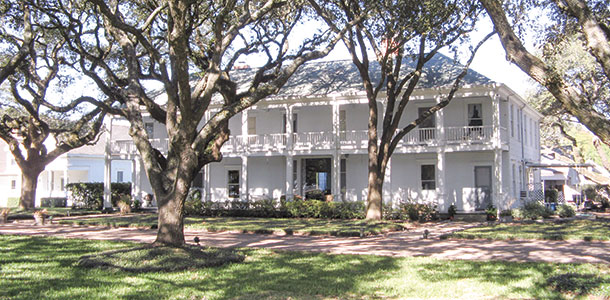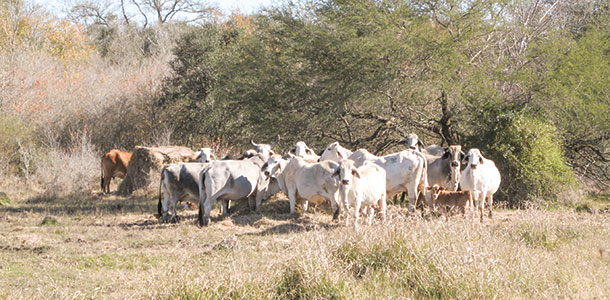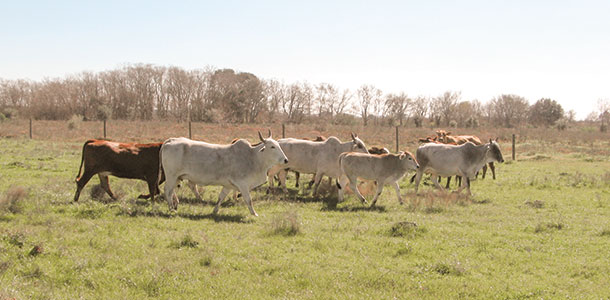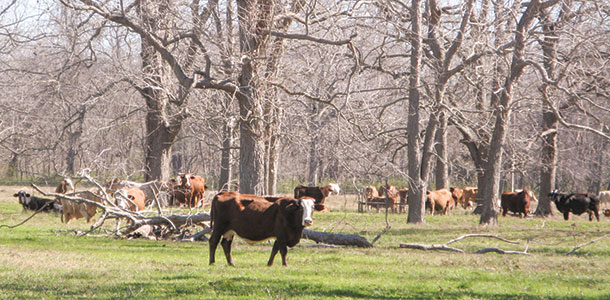Maverick County, of which Eagle Pass is the major city, is on the western edge. Highway 90 is considered the northern boundary.
The southern sub-tropical portion of this region is known as the Rio Grande Valley and the eastern side along the Gulf of Mexico is often referred to as the Coastal Bend. The western and central parts are called the South Texas Plains or the brush country.
Coastal Bend areas are warm most of the year due to currents off the Gulf of Mexico but can get cold in winter if a strong front comes from the north. Summers are hot and humid with the wettest months being in April and May. Rainfall averages around 46 to 47 inches.
South Texas Brush Country is characterized by plains of thorny shrubs and trees, such as mesquite, acacia and prickly pear, mixed with areas of grassland. Soils of the region are alkaline to slightly acidic clays and clay loams.
The deeper soils support tall brush, such as mesquite and spiny hackberry, whereas short, dense brush grows in the shallow, caliche soils.
Daily high temperatures are often over 100ºF for most of the summer and the average annual rainfall of 20 to 32 inches increases from west to east. Drought, extremely high temperatures, and several species of ticks create continual challenges for South Texas cattlemen.
Most South Texas ranches cross Brahman with English and Continental breeds to obtain heterosis for improved production, but retain the heat, insect, and disease resistance of the Bos indicus cattle.
Ranch managers reduce negative impacts of drought with good pasture management and stocking below carrying capacity.
Financial risk is reduced by diversifying among several profit centers in addition to cattle. Common enterprises are farming, hunting, and tourism. Many South Texas ranches have been owned by the same family since the 1800s.
Pierce Ranch

The Pierce Ranch is located between Wharton and El Campo, Texas, and was founded in the early 1800s by A.H. “Shanghai” Pierce, one of the most colorful cattlemen in early Texas history.
At the age of 19, Pierce stowed away on a ship in the Newport, Virginia harbor. He worked for his passage and arrived in Indianola, Texas, five months later without money or a job. He went to work for W.B. Grimes as a ranch hand, and later William Lacy where he met his wife, “Fannie.”
“Pierce eventually started his own cattle business and began seeking a breed that was resistant to the ticks so prevalent in the Texas Gulf Coast area,” says Laurance Armour, a sixth-generation family member and manager of the ranch.
“After seeing and purchasing a Brahman bull and cow at a circus in Louisiana, he toured India and present day Pakistan to purchase more of the cattle. Pierce died on Dec. 25, 1900.
“In 1903, Abel Pierce Borden, nephew of Shanghai and executor of the estate, was sent to New York where the Brahman cattle had arrived in the United States. The only problem was that they had been quarantined on Ellis Island because of blue tongue disease incidences in India.
Even though the cattle were not showing any symptoms of the disease, it took a presidential order from Teddy Roosevelt to get the cattle released. Those animals are the foundation of present day Brahman cattle in the United States.”
“Shanghai Pierce married Fannie Lacy and they had two children – a daughter, Mary Francis, and a son who died at the age of 4 months,” relates Armour. “Through marriage, Mary Francis obtained the last name, Withers.
The ranch continued to be passed down through the female side of the family, and in the mid-1950s it was owned by two sisters, Mary Runnells and Lacy Armour. In 1956, they split the ranch.

The Withers portion was named the Runnells-Pierce Ranch and was managed by her sons, the Runnells. The Armour family retained the Pierce Ranch name for their portion.”
Presently, Pierce Ranch is diversified among cattle, farming, hunting and tourism. The farming operation is comprised of cotton, corn, milo and hay. Rice is grown when irrigation water is available from the Colorado River.
Hay is produced for the ranch cattle and to sell to other livestock producers. Karankawa Plains Outfitting Company manages the tourism enterprises which offer hunting (water fowl, upland game birds, deer and wild hogs), fishing, canoeing, birding, nature trails, food services, lodging, entertainment and equestrian events.
“Our cattle operations include Braford seedstock and cow-calf enterprises,” explains Armour. “Brafords are F1 crosses between Brahman and Hereford cattle, which provide heterosis or hybrid vigor.
Heterosis improves reproduction and maternal traits in cattle. The Brahman adds parasite and heat resistance to the cross. We sell Brafords to commercial producers up and down the Texas Gulf Coast.
“We breed Braford cows with Charolais bulls for our commercial cow-calf herds,” Armour continues. “The three-way cross gives us our desired carcass traits. Our calves are sold to contract buyers who deliver them to stocker operators or feedlots.”
Pasture forage is the main constituent of the cattle nutrition program. Ranch-produced hay is fed during the winter as a nutrient supplement, and Purina Accuration range liquid is available for replacement heifers year-round.

Armour says that weed control is very important for maintaining a good forage supply and sprays his pastures annually. In most years, he is able to maintain a stocking rate of an animal unit for every 7 acres and keep his pastures in good condition.
Runnells-Pierce Ranch
The Runnells-Pierce Ranch is headquartered near Bay City, Texas, approximately 18 miles from Pierce Ranch headquarters, which provides some perspective on the size of the original Pierce holdings.

A few years after the Pierce Ranch split, Mary Runnells divided her property by placing one portion in a partnership of herself and her eldest son, John Runnells I. Her youngest son, Clive Runnells I acquired all the non-contiguous tracts around Ashwood, Markham, and Collegeport, Texas.
Today Clive Runnells III owns and operates the Markham property as C3 Cattle Company. The other tracts have been sold. Runnells-Pierce Ranch is operated as a family limited partnership between John Runnells III and his two sisters, Mary and Gale.
“Today, the Runnells-Pierce Ranch is primarily a cow-calf operation,” says John Runnells III. “We breed Charolais bulls to Simbrah cows and SimAngus (Simmentals + Red Angus) bulls to Simbrah heifers.
Several different breeds of bulls have been tried, but we found the SimAngus bulls to provide good calving ease.
“We graze mixtures of common bermuda, dallisgrass, bahia and gordo bluestem during the summer months and oat/annual ryegrass pastures during the winter,” Runnells continues. “Smutgrass can be a problem, but we control it by shredding to keep it in a tender stage so the cattle will eat it.

We aerially spray weeds when there is not the possibility of damaging cotton. Thatch removal plus added weed control is achieved with prescribed fire. The winter feeding program consists of liquid protein, cottonseed and hay. Minerals are fed free-choice year-round.”
The Runnells-Pierce Ranch is diversified with cattle, farming and hunting. Lessees raise corn, milo, cotton and organic rice. Along with the cattle, Runnells directly manages the pecan orchards and deer hunting leases.
Running V Ranch
From the Coastal Bend, we move west onto the South Texas Plains to Jourdanton, just south of San Antonio. The South Texas Plains are drier than the Coastal Bend and are characterized by thick spiny brush and grasslands.
Winters are cold and dry as Arctic air moves into the region and summers are usually hot and dry. At times the weather can be humid when winds come off the warmer Gulf of Mexico.

The Running V Ranch is owned by Suzanne Schuchart and her husband, Pat. Suzanne is a fourth-generation rancher and inherited the ranch through her mother’s side of the family.
Her great-great-grandmother and grandfather started amassing land in 1915 by buying small tracts, and each succeeding generation bought additional tracts. Present land holdings consist of two large ranches one mile apart, and the Schucharts continue to enlarge their operation by buying more land. The “V” in the Running V Ranch name comes from Viola, Suzanne’s grandmother.
“We maintain a herd of Braford cows which we breed to Angus bulls for a second herd of cattle that are quarter Hereford, quarter Brahman and half Angus,” says Suzanne Schuchart. “Our breeding programs are resulting in animals that are good producers, adapted to the South Texas climate, that have good carcass quality.
The heifers are sold to other producers for herd replacements, and the steers are marketed through local auction sales or to contract buyers. We maintain a 90-day breeding season in the fall and cull cows that don’t conceive during that period. Low-stress handling techniques are employed, which results in docile cattle.
“With electric fencing, we partition 80- to 320-acre paddocks in our pastures and move cattle frequently,” Schuchart continues. “This method of grazing releases forbs for wildlife but leaves enough grass to allow good regrowth. We have 30 earthen tanks on the ranch which went dry during the drought.
The opportunity is being taken to clean sediment from the tanks while they are dry. We also have a system of piping and troughs in each pasture that transports water from wells. The troughs are positioned so that our cattle never have to walk too far for water.
In addition, our watering systems include ground level waterers for wildlife.”
The Running V Ranch sells a few deer hunting leases but retains enough area for family and friends to hunt. Wildlife habitat maintenance is one of the ranch’s management objectives, so the Schucharts strive for the proper balance of grass, forbs and brush to provide food and cover.
The three interviewed ranchers are rightfully proud of their ancestors and are thankful for their inheritances. They in turn are building a legacy to pass to their children. ![]()
Robert Fears is a freelance writer based in Texas.
PHOTOS
PHOTO 1: Progressive Cattle Country - Texas
PHOTO 2: The original Shanghai Pierce home on the ranch is still occupied.
PHOTO 3: Pierce Ranch breeds Angus bulls with heifers and Hereford bulls with Brahman to produce Braford seed stock.
PHOTO 4: Pierce Ranch replacement heifers.
PHOTO 5: Heifers on a winter pasture of Gulf Coast perennial ryegrass at the Runnells-Pierce Ranch.
PHOTO 6: Cattle grazing native pecan orchard on Runnells-Pierce Ranch. Both pecans and beef production are ranch profit centers.
PHOTO 7: Suzanne and Pat Schuchart standing in one of their well-managed pastures. Photos courtesy of Robert Fears









